International Journal of Civil and Structural Engineering Research ISSN 2348-7607 (Online) Vol. 7, Issue 2, pp: (97-105), Month: October 2019 - March 2020, Available at: www.researchpublish.com
Fracture Behaviour ofAluminum Reinforced With Silicon Carbide and Borosilicate Glass
Engr. Prof. Jim E.O. Ovri1, Engr. Prof. I.C. Madufor2, Nwakiri Ekele C.3
1Materials And Metallurgical Engineering Department, Federal University Of Technology, Owerri, (F.U.T.O), Nigeria. E-mail: james.ovri@futo.edu.ng, Phone No. 0803-210-5902
2Polymer And Textile Engineering Department, Federal University Of Technology, Owerri, (F.U.T.O), Nigeria.
3 Corresponding Author And Master Of Engineering Scholar, Materials And Metallurgical Engineering Department, Federal University Of Technology, Owerri, (F.U.T.O.), Nigeria. E-mail Address: ekelezebunwa@gmail.com
Abstract: The fabrication of Engineering materials with properties combination of high hardness, impact resistance, ductility and light weights can only be obtained from metallic super alloy materials, which has led to the development of metal matrix composites, (MMC). Aluminium/Silicon carbide and Aluminium/Boro-silicate glass materials, were separately fabricated owing to their low density, high temperature strengths, etc.
Stir-casting process of fabrication was adopted because of it’s simplicity and flexibility, and also the use of sand mould.
The metal matrix composites (MMC’s) bars and circular plates are prepared with varying the reinforced particles by weight fraction ranging from, 5%, 10%, 15%, 20% and 25%. The average reinforced particle size of silicon carbide and also borosilicate glass was 100μm.
The mechanical tests of hardness, impact, ductility and tensile tests were carried out. Also the specific weights were also evaluated.
From the various mechanical tests and the physical property evaluation results it shows that aluminium reinforced with borosilicate glass material increases in strength and decreased specific weight with increasing reinforcement, and that 25% borosilicate glass reinforcement provides the best mechanical hardness and tensile strengths and also the best physical properties.
Metallographic analysis of the specimens, using Optical microscopic process, shows even particle distribution of reinforcements.
Keywords: Silicon carbide, borosilicate glass, Aluminium alloy, Al6063, Stir casting, hardness, impact, ductility, tensile strength.
I. INTRODUCTION
Composite materials have been one of the major areas of scientific and applied research for many decades; however, only in the past decade they have been viewed and applied as engineering materials. Today we have significant progress and advances in our understanding of these materials and their metallurgical behaviour. The greatest advantage is in the fact that we can inherit properties of both, the metal matrix and the reinforcements, providing a material with properties which can meet specific and challenging requirements in many applications[26].
Metal Matrix Composites (MMC’s) have very light weight, high strength, and stiffness and exhibit greater resistance to corrosion, oxidation and wear. These properties are not achievable with lightweight monolithic titanium, magnesium, and aluminium alloys. Particulate metal matrix composites have nearly isotropic properties when compared to long fibre reinforced composite. But the mechanical behavior of the composite depends on the matrix material composition, size, and weight fraction of the reinforcement and method utilized to manufacture the composite [28]. The distribution of the
International Journal of Civil and Structural Engineering Research ISSN 2348-7607 (Online) Vol. 7, Issue 2, pp: (97-105), Month: October 2019 - March 2020, Available at: www.researchpublish.com
reinforcement particles in the matrix alloy is influenced by several factors such as rheological behavior of the matrix melt, the particle incorporation method, interaction of particles and the matrix before, during, and after mixing. Non homogeneous particle distribution is one of the greatest problems in casting of metal matrix composites.
Aluminum-silicon carbide and aluminum-borosilicate metal matrix composites have low density and light weight, high temperature strength, hardness and stiffness, high fatigue strength and wear resistance etc. in comparison to the monolithic materials. However, aluminum alloy with discontinuous ceramic reinforced MMC is rapidly replacing conventional materials in various automotive, aerospace, and automobile industries. Amongst various processing routes stir casting is one of the promising liquid metallurgy technique utilized to fabricate the composites. The process is simple, flexible, and applicable for large quantity production. The liquid metallurgy technique is the most economical of all the available technique in producing of MMC [24].
In this study stir casting is accepted as a particularly promising route, currently can be practiced commercially. Its advantages lie in its simplicity, flexibility and applicability to large quantity production. It is also attractive because, in principle, it allows a conventional metal processing route to be used, and hence minimizes the final cost of the product. This liquid metallurgy technique is the most economical of all the available routes for metal matrix composite production, because it allows very large sized components to be fabricated [18].
In general, the solidification synthesis of metal matrix composites involves producing a melt of the selected matrix material followed by the introduction of a reinforcement material into the melt. To obtain a suitable dispersion the stir casting method is used. The solidification of the melt containing suspended SiC particles is done under selected conditions to obtain the desired distribution [15].
In this study, different weight fractions of Silicon Carbide particulates and also boron-silicate are added with aluminium matrix to fabricate the Aluminum/Silicon Carbide and the Aluminum/Borosilicate metal matrix composites. Different samples have been fabricated by melt-stirring casting and their microstructure, hardness, tensile strength, impact strength and specific weights are studied. In this study the influences of the reinforced weight fractions (5%, 10%, 15%, 20% and 25%) on mechanical properties like Hardness (RHB), Impact strength (KJ/m3), Tensile strengths and Ductility, (Percentage % Elongation, and Percentage % area reduction), Engineering/true stress (KN/m3)/strain conditions, physical properties of density/specific weights (KG/m3) and also the micro-structures were investigated.
II. STATEMENT OF PROBLEM
Literature depicts that considerable amount of work has been carried out by previous investigators to ascertain the mechanical and physical properties of Al6063-SiC composite, at different fractions of silicon carbide reinforcement using stir casting and other methods. But up till now no work has been published on Borosilicate glass as a particle reinforcement material for aluminium metal matrix composites, either in an attempt to study the mechanical, physical or any other property of the resultant material, in spite of the large applications and properties of borosilicate glass material.
III. OBJECTIVES OF THE STUDY
The fabrication of Engineering materials with properties combination of high hardness, high impact strength, high tensile strength, low specific weights, and low thermal expansion coefficient, can only be found in super metallic alloys, which also have operational challenges, and this type of material puts the production of Engineering materials at extreme high monetary costs.
Also, Engineering materials applicable to conditions of high temperatures, high mechanical pressures, strong acidic conditions etc, are susceptible to crack propagation and abrasion under mechanical pressures and acidic environments respectively.
Therefore, the main objectives in accomplishing of this work are as follows:
1. To synthesize silicon carbide particle reinforced aluminum metal matrix composite specimen and also borosilicate glass particle reinforced aluminum metal matrix composite specimen using STIR CASTING method.
2. To study the effect of weight fractions of silicon carbide and borosilicate glass on the hardness of aluminum metal matrix composites.
3. To study the impact strength of aluminum metal matrix composites at different compositions of silicon carbide and also borosilicate glass.
International Journal of Civil and Structural Engineering Research ISSN 2348-7607 (Online) Vol. 7, Issue 2, pp: (97-105), Month: October 2019 - March 2020, Available at: www.researchpublish.com
4. To study the effect of weight fractions of silicon carbide and borosilicate glass on the tensile strength and ductile behavior of aluminum metal matrix composites.
5. To study the effect of silicon carbide particle reinforcement and borosilicate glass particle reinforcement on the specific weight of aluminum metal matrix composites.
6. To study the effect of microstructures on the mechanical and physical properties of aluminum metal matrix composites at different compositions of silicon carbide and also borosilicate glass.
IV. MATERIALS AND METHODS
A. MATERIALS:
The materials for this research work is tailored to combine high strength to weight ratios, high temperature resistance alongside alignment and dimensional operations stability.Thus, the material constituents are; Aluminium Alloy, (6063), -Matrix, Silicon Carbide, (SiC) -Reinforcement, Glass, (Boro-Silicate Glasses), -Reinforcement,
Table 1.0: Properties Of Composite Sample Constituent Materials, (Meena, Banwalt and Jaswanti, 2013). Aluminium, Al6063 SiC Borosilicate Glass
Melting Temperature, (0C) 650 2,800 1,500 Density, (gm/cm3) 2.70 3.30 2.23 Modulus Of Elasticity, (Gpa) 70 345 80 Tensile Strength, (Mpa) 185 588 280 Coefficient Of Thermal Expansion, (x10-6/0C) 23 4.6 3.3
The metal matrix material used is Aluminium Alloy, 6063. Al6063 is a precipitation hardened alloy, containing magnesium and silicon as major alloys. It has good tensile strength, flexural and impact strengths, combined with good corrosion resistance, ease of formability and excellent anodization ability. Typical alloys in this group includes Al6061, Al6063, and Al6082, used for building structures applications, land and sea transport applications, etc.
Table 2.0: Chemical Composition Of Al6063 Alloy, (Aluminium Rolling Mills,(A.R.M.), Otta,Ogun State, Nig. 2016).
Constituents Si Fe Cu Mn Mg Zn Cr Ti Al Percentages (%) 0.45 0.22 0.02 0.03 0.50 0.02 0.03 0.02 98.71
Table 3.0: Chemical Composition Of Silicon Carbide, (C.M. Advanced Ceramics, Shanghai, China, 2015).
Constituents SiO2 Coke(C) Al2O3 ZrO2 Y2O3 B2O3 Percentages(%) 56.0 36.0 1.0 3.0 2.5 1.5
Table 4.0: Chemical Composition Of Borosilicate Glass, ( Schott Borofloat, Wolfsburg, Germany, 2016).
Constituents SiO2 B2O3 Na2O Al2O3 Percentages (%) 81.0 13.0 4.0 2.0
The methodological procedures employed in producing our samples and working out the material properties are as follows,
International Journal of Civil and Structural Engineering Research ISSN 2348-7607 (Online) Vol. 7, Issue 2, pp: (97-105), Month: October 2019 - March 2020, Available at: www.researchpublish.com
B. FABRICATION OF SAMPLES, [STIR CASTING PROCESS],
The fabrication of the composite samples of Al/SiC, and Al/B-Glass, follows the same process. Stir casting process was adopted due to it´s simple set-up, and cost.
For each composite sample, the aluminium scrap is initially melted, at 6500C temperature, the molten metal and reinforcement mixture (powder) is poured in and stirred in order to distribute the reinforcement effectively in the matrix metal. Hence, the reinforcement is added as powder into the molten metal, while Al6063 alloy is held, in the furnace.

With the addition of particle reinforcement, the molten metal is vigorously mechanically stirred. Then, the admixed melt is poured/casted in a sand mold with standard dimension. The molten composite mixture is allowed to solidify for 24 hours, before the machining process.
Figure 1.0: Stir Casting Process, For Making Aluminium Metal Matrix Composites, (AMMC), (Neelima and Surowska, 2000).
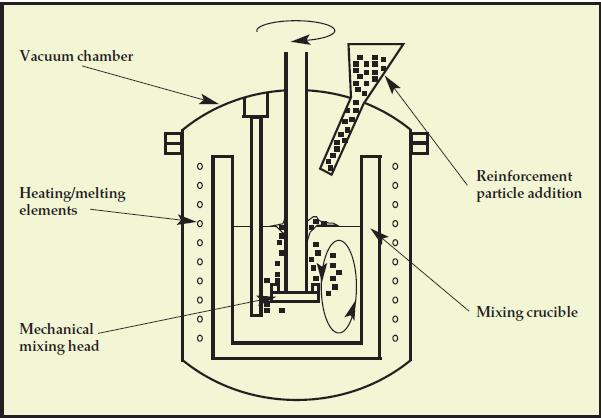
C. Machining Of Samples And Failure Nature
The samples for hardness, impact and tensile tests, where machine according to standard test dimensions,

Figure 2.0: Hardness Test Sample Before Identation, ø40mm, 15mm Thick Gauge, (Material Lab, FUTO , Owerri).
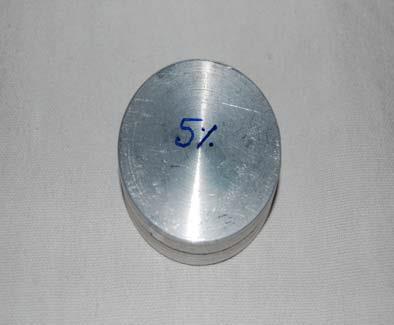
Figure 3.0: Impact Test Specimens Before Fracture
Figure 4.0: Impact Test Specimens After Fracture, (Materials Lab. FUTO, Owerri). (Materials Lab. FUTO, Owerri).
International Journal of Civil and Structural Engineering Research ISSN 2348-7607 (Online) Vol. 7, Issue 2, pp: (97-105), Month: October 2019 - March 2020, Available at: www.researchpublish.com
Figure 5.0: Tensile Test Specimens Before Fracture, Figure 6.0: Tensile Test Specimens After Fracture, (Materials Lab. ESUT, Enugu). (Materials Lab. ESUT, Enugu).
V. RESULTS AND DISCUSSIONS
A. HARDNESS TEST RESULTS,
The hardness values of the composites were evaluated from the average penetration diameters of three readings and equivalent hardness as computed below.
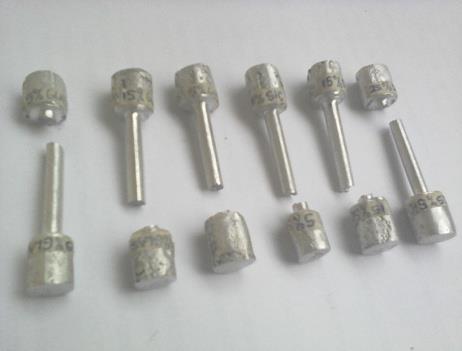
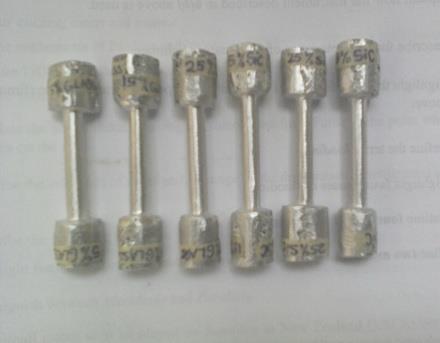
Figure 7.0: Hardness Values Of Composites, Using Al6063 As Control,
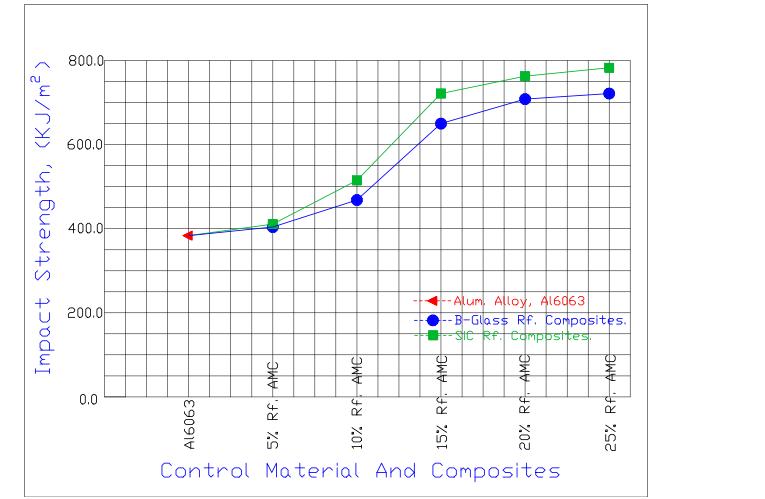

B. IMPACT TEST RESULTS,
The values of the Impact Strength of the composites were evaluated from the values of the Impact energy and the area under notch, and evaluated as follows,
Figure 8.0: Impact Strength (KJ/m2) Of Composites, Using Al6063 (398.8 KJ/m2) As Control,
International Journal of Civil and Structural Engineering Research ISSN 2348-7607 (Online) Vol. 7, Issue 2, pp: (97-105), Month: October 2019 - March 2020, Available at: www.researchpublish.com
C. DUCTILITY OF THE COMPOSITES, (PERCENTAGE,% ELONGATION),
The percentage (%) elongation of the composites were evaluation and results shown below,
Figure 9.0: Percentage (%) Elongation Of Composites, Using Al6063 (5.83%) As Control,
D. DUCTILITY OF THE COMPOSITES, (PERCENTAGE,% AREA REDUCTION),
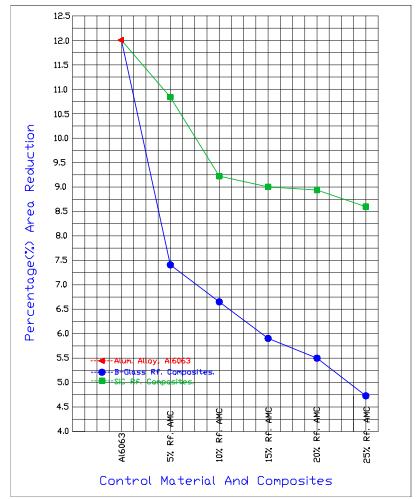
The percentage (%) area reduction of the composites were evaluated and the results shown below,
Figure 10.0: Percentage (%) Area Reduction of composites using Al6063, (12.02%) as control.
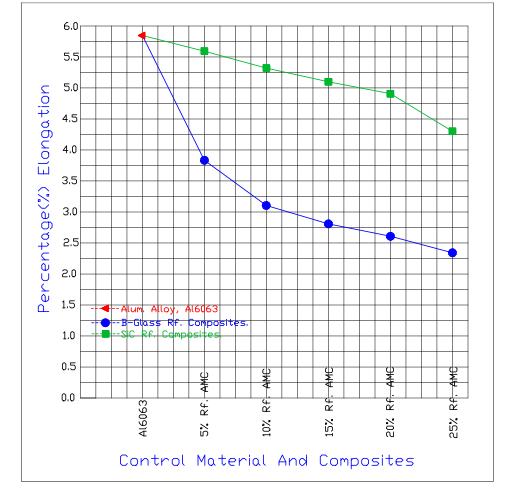
E. ENGINEERING STRESS/STRAIN AND TRUE STRESS/STRAIN RESULTS FOR Al 6063, 25% SiC RF AMC. AND 25% BOROSILICATE GLASS RF. AMMC’S
Figure 11.0: Engineering/True Stress Vs Engineering/True Strain For Al6063, AMC 25% SiC, And AMC 25% Borosilicate Glass,

International Journal of Civil and Structural Engineering Research ISSN 2348-7607 (Online) Vol. 7, Issue 2, pp: (97-105), Month: October 2019 - March 2020, Available at: www.researchpublish.com
F. DENSITY EVALUATION RESULTS,
The density values of composites were evaluated using the Rule of mixtures and the results are shown below,
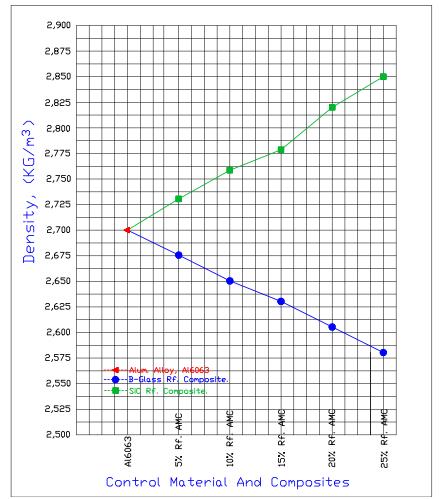
Figure 12.0: Density (KG/m3) Of Composites, Using Al6063 As Control,
G. Metallographic Examination Results:
The metallographic test results reveal the micro-graphic composition for the Al/SiC and Al/B-Glass composite material for (5%, 15% and 25%) particle reinforcements. Thus: a. b. c
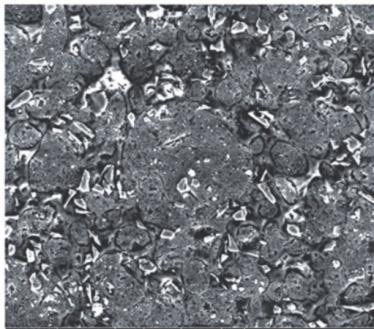
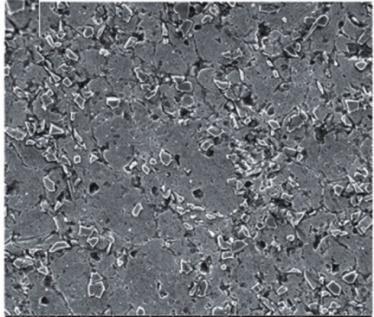
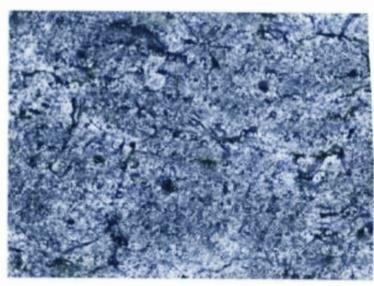

Figure 13.0.(I): Specimen Micro-structures, a) 5% SiC Micrograph, 100ϻm, b) 15% SiC Micrograph, 100ϻm, and c) 25% Micrograph, 100 ϻm. (Magnification: x1000) d. e. f.
Figure 14.0, (II): Specimen Microstructures for, d) 5% B-Glass AMMC, 100ϻm, e)15% B-Glass AMMC,100ϻm and f) 25% B-Glass AMMC, 100ϻm. (Magnification: x1000)
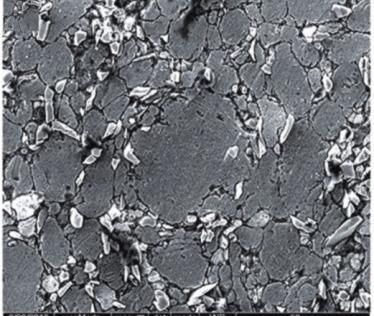
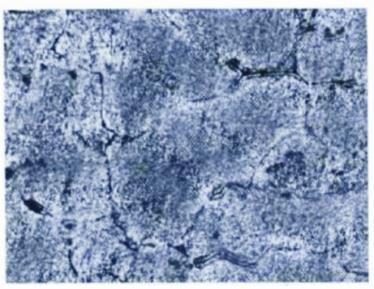
VI. CONCLUSION AND RECOMMENDATIONS
A. CONCLUSION:
This research work reveals the following; The Optical Micrographic and Metallographic studies shows that stir-casting process of fabrication of composite samples results to reasonable uniform particle distribution of SiC particles in Al/SiC, and glass particles in Al/B-glass composite , because of the isotropic nature of the micro-structural morphology.
International Journal of Civil and Structural Engineering Research ISSN 2348-7607 (Online) Vol. 7, Issue 2, pp: (97-105), Month: October 2019 - March 2020, Available at: www.researchpublish.com
The density test of the samples with results of 2700, 2730, 2760, 2790, 2820, and 2850 KG/m3 shows that while the specific weight of Al/SiC material increased linearly from Al6063 to AMMC 25% SiC reinforcement, that of Al/B-Glass with the results, 2,700, 2,676.5, 2,653, 2,629.5, 2,606, and 2,582.5 KG/m3 shows a linear decrease from Al6063 to AMMC 25% B- Glass reinforcement, with the best specific weight of 2,582.5 KG/m3 for AMMC 25% B-Glass.
The hardness test of the samples with results of, 28, 31, 40, 57, 65, and 68 RHB for Al6063 and SiC AMC reveals that penetration resistance of samples increased from Al6063 to AMC 25% SiC and also, increased linearly for Al6063 and B-Glass AMC with results of, 28, 40, 57, 68, 72, and 79 RHB values, with the best penetration resistance of 45.8 RHB value for AMC 25% B-Glass.
The Impact test results with values for Al6063 and SiC AMC of 39.88, 40.64, 50.53, 72.34, 76.43, and 78.00 KJ/m3 shows that the shock absorption strength of Al/SiC increased from 5% to 25% SiC Rf. while that of Al6063 and B-Glass AMC with values of 39.88, 40.16, 46.48, 25.09, 71.25, and 72.98 KJ/m3 also increased from 5% to 25% B-Glass reinforcement, where 25% SiC has the best shock absorption strength of 78.00KJ/m3.The ductility (percentage elongation) results of 5.83, 5.63, 5.33, 5.17, 4.63 and 4.33% for Al6063 and SiC AMC, and for Al6063 and B-Glass AMC with results 5.83, 3.80, 3.17, 2.80, 2.60, and 2.33 shows highest percentage elongation value of 5.83% for Al6063, 4.33% for AMC 25% SiC, and lowest percentage elongation of 2.33% for AMMC 25% B-Glass. Ductility, (Percentage area reduction), for Al6063 and SiC AMC with results, 12.02, 10.85, 9.27, 9.01, 8.96, and 8.60% and 12.02, 7.43, 6.67, 5.91, 5.50, and 4.47% reveals highest cross-sectional area reduction of 12.02% for Al6063, 8.60% for AMC 25% SiC and lowest cross-sectional area reduction of 4.74% for AMC 25% B-Glass.
Stress-strain(Engr.) reveals that Al6063 UTS, 132.28 N/mm2, fractured at 117.11 N/mm2 tensile strength, 25% SiC-AMC at 142.57 N/mm2, while 25% B-Glass-AMC at 152.57 N/mm2
B. RECOMMENDATIONS:
Stir-casting process should be adopted for the mass production of Silicon Carbide and Boro-Silicate Glass reinforced Aluminium matrix composites (AMC) because of the advantage of uniform distribution of particles within the material’s micro-structures. 25% Boro-silicate Glass Aluminium metal matrix composites should be adopted as an Engineering material and should be applied to structures where high strength-to-weight, and stiffness-to-weight ratios are required, like the building and construction, Maritime and ship construction, aeronautics and aerospace, food processing industries, etc.
From the properties of 25% borosilicate glass reinforced aluminium MMC, having properties such as zero crack propagation rate on impact, high tensile strength under tension, high penetration resistance, low specific weight, amongst others, this material should be subjected to further studies whether or not to be consideration as a super engineering material and also to ascertain the possibility of applying it in other fields of engineering.
REFERENCES
[1] Allison, J.E. and Cole, G.S. (1993); Metal matrix composites in automotive industry: Opportunities and challengies, Journal of mechanical science, 19-24.
[2] Balasivanandha, S., Kaarunamoorthy, L., Kaithiresan, S. and Mohan B. (2006); Influence of stirring speed and stirring time on distribution of particles in cast metal matrix composites, Journal of material processing technology, 268-271.
[3] Barry Cordage (2012); Technical properties of synthetic fibres, 1-10.
[4] C. Neelima Devi, N. Selvaraj, and V. Mahesh; (2012); Micro structural Aspects Of Aluminium Silicon Carbide Metal Matrix Composites, Int’l Journal Of Applied Sciences And Engineering Research, 50-56.
[5] Campbell F.C. (2010); Introduction to composite materials, 10-14,
[6] Carl Zwenben, (1987); Metal matrix composites, 101-103,
[7] Chandramohan D. and Marimuthu K., (2011); A review of natural fibres, 73-77,
[8] Chawla, N., (2006); Metal matrix composites in automobile applications, Advanced materials processing, 29-31.
International Journal of Civil and Structural Engineering Research ISSN 2348-7607 (Online) Vol. 7, Issue 2, pp: (97-105), Month: October 2019 - March 2020, Available at: www.researchpublish.com
[9] Chicao G., Xuezheng Zhang, Tijun Chen And Yushi Chen, (2016); Effects of processing parameters on microstructure and mechanical properties of powder thixoforged Sic/6061 Al composite, Int’l research journal on materials engineering, 5-8.
[10] D.M. Skibo, D.M. Schuster, and L. Jolla, (1988); Process for preparation of composite materials containing nonmetallic particles in a metallic matrix, 467.
[11] Davis J.R. (2001); Aluminium and aluminium alloys, 362-363.
[12] Doel T.J.A., Lorretto M.H. and Bowen, P. (1993); Mechanical properties of aluminium based particulate metal matrix composites, Journal of composites, 270-273.
[13] Eugenio Pezzuti and Giampiero Donnici, (2014); Structural composites for aircraft design. Applied science and engineering journal, 10-14,
[14] Gnjidi, X.., Boi, D. and Mitkov, M. (2001); The influence of SiC particles on compressive properties of metal matrix composites , Materials characterization, 129-137.
[15] Hashim J., Looney L. and HashmaM.S.J. (2002); Particle distribution in metal matrix composites, journal of materials processing technology, 251-257.
[16] Ibrahim, I.A., F.A. Mohamed, E.J. Lavernia, (1991); Metal matrix composites-A review, Journal of materials science, 1137-1145.
[17] Idenyi N.E. and Nwajagu C.O. (2003); Non-metallic materials technology, 1-6,
[18] Jamaluddin Hindi, U. Achutha Kinl, and S.S. Sharma, (2015); Mechanical characterization of stir cast Al6063 matrix Sic reinforced metal matrix composites. Int’l research journal on mechanical and materials engineering, 6367.
[19] Jaroslaw Bienias And Barbara Surowska, (2000); Select Micro-structural And Corrosion Aspects Of Aluminium Alloy Metal Matrix Composites, International Journal on Composites, 1-8,
[20] Jim E.O. Ovri, (2015); Lecture material on advanced fracture mechanics, 6-7, [21] K. L. Meena, Dr. A. Manna, Dr. S. S. Banwalt, Dr. T. Jaswanti, (2013);
[22] An analysis of mechanical properties of the developed Al/SiC MMC’s, 14-19,
[23] Lloyd, D.J., Lagace, H., Mcleod, A., and Morris, P.L. (1989); Micro-structural aspect of aluminium-silicon carbide particulate composites produced by a casting method, materials science and engineering, 73-75.
[24] Lucas, J.P., Stephens, J.J. and Greulich, F.A. (1991); The effect of reinforcement on the stability on composition redistribution in cast aluminium metal matrix composites, Materials science and engineering, 221-227.
[25] Mahendra Boopathi M., K.P. Arulshri and N. Iyandurai, (2013); Evaluation of mechanical properties of aluminium alloy 2024 reinforced with silicon carbide and fly ash hybrid metal matrix composites, int’l research journal on materials engineering, 5-9,
[26] Manna, A. and Bhattacharyya, B., (2003); Study on different tooling systems during turning for effective machining of Al-Sic MMC. Int’l Journal of production engineering, 46-50.
[27] Manoj Singla, D. Deepak Dwivedi, Lakhvir Singh, Vikas Chawla, (2009);
[28] Development of Aluminium based silicon carbide particulate metal matrix composite, 455-467,
[29] Maria Mrazora, (2013); Advanced composite materials of the future in aerospace industry, 139-150,
[30] Meena K.L., Dr, A. Manna, Dr. S.S. Banwait, and Dr. S. Jaswanti, (2013); An analysis of mechanical properties of the developed Al-Sic MMC. Mechanical engineering research journal, 58-61.
[31] Michael Chun-Yung Niu, (1988); Aircraft structural design. 101-102.
[32] Muniyasamy kalachian and Moorthy Chinnasamy, (2012); Advantages of composite materials in aircraft structures, International Journal of mechanical, Aerospace, Industrial, Mechatronic and Manufacturing Engineering, 5-10,
